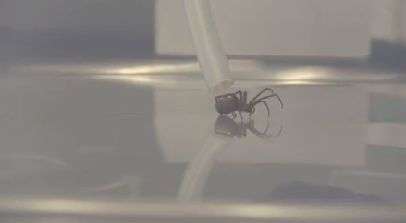'Milking' brown recluse spiders for silk

(Phys.org) —Rabbit, a brown-recluse spider, is fastened to the proverbial treadmill in Hannes Schniepp's Nanomaterials & Imaging lab. She is restrained but relaxed. Her spinnerets are churning out exquisite ribbons of silk. The strands are being captured on a creatively crafted spindle.
Among her sister spiders in the lab, Rabbit is a star. She, according to Sean Koebley '08, hands-down is the most reliable, most profuse when it comes to spinning. He handles her gently, secures her with soft strips of cotton; he is, after all, the one who named her—"Rabbit," the nickname for Maria ("my little Rabbit") in Ernest Hemingway's For Whom the Bell Tolls.
The silk is exquisite, even from the vantage of veteran material scientist Schniepp, assistant professor of applied science at William & Mary. Unlike that of other spiders, brown recluse silk essentially is flat, not cylindrical. Although two scientific papers had identified that ribbon-like characteristic, those papers had been written from "a biologist's point of view," Schniepp explained. He and his assistant Koebley, along with Fritz Vollrath, a professor in the department of zoology at Oxford, were the first to subject it to materials testing.
"Essentially we can 'milk' the spider for its silk under controlled conditions," Schniepp said. "That allows the silk to be placed, measured and tested for strength."
The William & Mary team was able to measure the silk on an atomic force microscope in the applied science department. Their resulting paper, published in Advanced Materials, suggested a base width for the silk of 6-to-8 micrometers; its thickness is between 100-150 times less.
"The beautiful thing is that, despite having a completely different shape, the brown recluse silk is at least as strong, stiff and tough as all the other silk fibers," Schniepp said. "In addition, as a material, the brown recluse silk behaves very differently when it comes to adhesion."
In short, it is sticky. Schniepp compares it to packaging tape, only it is super strong (five-times tougher than Kevlar) and it is only a few molecular layers thin.
In the applied science lab, the scientists are very interested in how the protrusions they discovered on the silk—they named them "nano-papillae"—affect the stickiness and flexibility of the substance. The feature has not been observed in any other silk, they say.
Meanwhile, the routines continue. Rabbit and her sisters emit their threads; yes, they all are female; "virgins," at that, Schniepp explains, a precaution against laboratory infestation. The scientists dutifully calculate and record their observations, rarely giving themselves over to the potential magnitude of what is transpiring.
When they do, they talk about how their work paves the way to synthesizing brown recluse-inspired thin silk films in the future. They say application of such materials as a coating for implant materials is virtually a no-brainer. Beyond that, the resulting applications become industrial in scale: Synthetic silks have great potential to replace a variety of structural materials including plastics and even metals, such as steel.
Indeed, their article in Advanced Materials begins, "With oil reserves dwindling, the search for sustainable synthetic polymers 'fit for' the 21st century is accelerating."
They resist talking about, yet they potentially are on the leading edge of such a search.
More information: Schniepp, H. C., Koebley, S. R. and Vollrath, F. (2013), "Brown Recluse Spider's Nanometer Scale Ribbons of Stiff Extensible Silk." Adv. Mater., 25: 7028–7032. DOI: 10.1002/adma.201302740
Journal information: Advanced Materials
Provided by The College of William & Mary




















